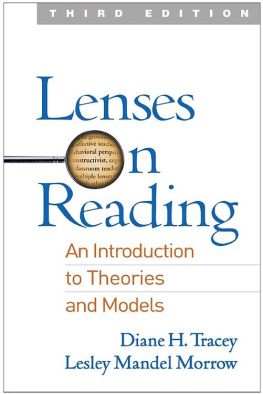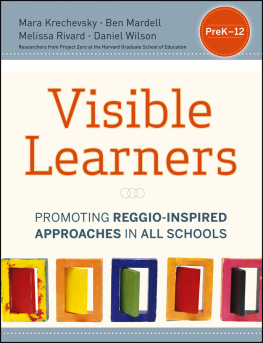

Published by Redleaf Press
10 Yorkton Court
St. Paul, MN 55117
www.redleafpress.org
2015 by Miriam Beloglovsky and Lisa Daly
All rights reserved. Unless otherwise noted on a specific page, no portion of this publication may be reproduced or transmitted in any form or by any means, electronic or mechanical, including photocopying, recording, or capturing on any information storage and retrieval system, without permission in writing from the publisher, except by a reviewer, who may quote brief passages in a critical article or review to be printed in a magazine or newspaper, or electronically transmitted on radio, television, or the Internet.
First edition 2015
Cover and interior design by Ryan Scheife, Mayfly Design
Cover artwork composed from images: (white background visible through the blue paper wrapped) inxti/iStockphoto; (Green vintage background texture) Maly Designer/iStockphoto; (photo of child) by Crystal Devlin and Jason Devlin
Typeset in the Quadraat OT and Whitney typefaces
Interior photos by Crystal Devlin and Jason Devlin
Library of Congress Cataloging-in-Publication Data
Beloglovsky, Miriam.
Early learning theories made visible / Miriam Beloglovsky, Lisa Daly.
pages cm
Summary: Go beyond reading about early learning theories and see what they look like in action in modern programs and teacher practices. Each theory is definedthrough engaging stories and rich visualsin relation to cognitive, social-emotional, and physical developmental domainsProvided by publisher.
Includes bibliographical references and index.
ISBN 978-1-60554-383-3 (e-book)
1. Early childhood education. 2. Child development. 3. EducationPhilosophy I. Daly, Lisa. II. Title.
LB1139.23.B45 2015
372.21dc23
2014023961
To our mentors for your guidance and wisdom.
To our students for inspiring us and reinforcing our commitment to the field.
To our colleagues for sharing the journey of preparing early childhood educators.
To our families for your support and encouragement.
Contents
W riting this book has been an incredible learning process. I am thankful to have embarked on this journey with my friend and writing partner Lisa Daly. Her integrity, creativity, and knowledge are a source of inspiration. This process was enriched by the incredible support from Alexis Baran, Arielle Baran, Alex Rudnicki, and Max Jaffee. Their encouragement, wisdom, ideas, designs, and editing made my own writing stronger. I want to thank my parents, sister, niece, and nephew for being there. And my friend Chris Marks who gave me the freedom to work the long hours. To my Niqui and Diego for their enthusiasm and love. Miriam Beloglovsky
This book could not have been written without the support and encouragement of many family members, friends, colleagues, students, and editors. I treasure my writing collaboration with my dear friend Miriam Beloglovsky. I value our friendship and her reflective and academic abilities. For generous encouragement and countless listening hours during the writing process, I thank my California and Colorado families. They have always believed in me, supported me, and encouraged me to pursue my dreams. To my husband, Dan, I am forever grateful for his constant love, support, and patience. I would like to give sincere appreciation to my children, Ted and Jenna, who are a blessing and an inspiration. My colleagues Janis Jones, Debora Larry-Kearney, and Eunyoung Hwang provided continual encouragement and important insight over numerous lunch engagements. My 6:00 a.m. workout partners at Curves and my friend Kathie Congdon, who walks the trails of Folsom Lake with me every morning, helped to relieve stress. Lisa Daly
We express our thankfulness to Crystal and Jason Devlin and all the children and families at Crystals Creative Kids who provided the real-life stories. We want to thank David Heath, Kyra Ostendorf, and Redleaf Press for believing in this book. Our gratitude also goes to Elena Fultz for her thoughtful editing and guidance. Miriam and Lisa
M any students in our college early childhood education (ECE) courses teach in community early care and education centers. Some of these students enroll in our college classes to fulfill employer- or state-mandated licensing requirements. A smaller percentage of students have never worked in the ECE field but plan to in the future. Often many of our students have received their teaching positions prior to meeting all of the state regulations.
What is common to all students, regardless of why they are in classes, is their experience with the ideals of in-class theory versus the realities of real-life practice. They see a huge discrepancy between what is happening at their work sites or during field observations and the developmentally appropriate practices that are taught in their ECE classes. During classes students often share their frustration with inappropriate practices in the field and having to follow a standardized curriculum that is overwhelming for them and the children they teach. They comment on how they desire to work in the early learning classrooms described during our class meetings but question if such programs really exist. They marvel at our presentations that depict inspiring programsthe ones that show intriguing environments, meaningful activities, and children who are joyful in their explorations and experimentations. Frequently our students ask how they can approach their supervisors about making changes. They know what is best for children based on what they are learning in classes, and it resonates with them. Yet they find that they are unable to articulate their position about what they know is best for children.
Challenges Educators Face
If you have experienced these feelings, you are not alone. Many teachers today experience frustration in expectations to implement inappropriate practices, are overwhelmed by content standards, and are unable to articulate a philosophy of education and advocate for the right of children to learn through direct, active, hands-on experiencesthat is, through play. These are serious challenges that face the field of ECE today.
Leaving Play-Based Curriculum for Prepared Curriculum
Early childhood professionals understand that children learn through play-based experiences, and yet many teachers find it a challenge to implement teaching strategies that support childrens learning through play. It is increasingly difficult for teachers to provide experiences for children that are active, child-centered, intellectually engaging, and constructive. There is pressure from well-intentioned groups, such as policy makers and administrators, to push academics for young children, and many teachers are required to teach using a prepared curriculum. Families, too, are worried that their children will not be prepared for kindergarten without what they consider to be academic rigor.
And yet prepared curriculum often has little interest to children, in part because it often contains activities that are inappropriate and involves meaningless tasks. It typically does not take into consideration how children learn. The rationale to use such curriculum is to improve standardized test scores and prepare children academically for kindergarten, not to support their growth and development. Prepared curriculum also limits teachers critical thinking, creativity, and active engagement in curriculum development based on the needs and interests of the children they teach.
Next page




